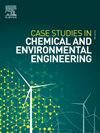常压微波等离子体热解过程中产生的甘蔗渣生物炭与纳米零价铁(nZVI)复合吸附剂快速高效吸附Cr(VI)
Q1 Environmental Science
Case Studies in Chemical and Environmental Engineering
Pub Date : 2025-01-27
DOI:10.1016/j.cscee.2025.101123
引用次数: 0
摘要
蔗渣的木质素含量为25 - 28%,可转化为生物炭,由于其高表面积而成为一种有前途的吸附剂。纳米零价铁(nZVI)以其强磁化和结合重金属的能力而闻名。本研究将蔗渣生物炭与nZVI按不同比例(1:1、2:1和3:1)复合,以提高对Cr (VI)的吸附效率。该复合材料采用等离子体热解法合成,然后加入nZVI。在不同的Cr (VI)浓度、接触时间、pH值和吸附剂剂量下进行了批量吸附试验,以确定每种比例的最佳条件。对吸附剂进行了XRD、BET、FTIR、SEM、VSM、Zeta电位等表征。对甘蔗渣和生物炭的XRD分析表明,热解后的结晶度和粒度有所改善。BET结果表明,蔗渣生物质的表面积为0.061 m2/g,转化为生物炭后增加到87.50 m2/g。但与nZVI复合后,其表面积分别降至37.44 m2/g(1:1)、49.26 m2/g(2:1)和62.37 m2/g(3:1)。FTIR和SEM分析揭示了生物炭与nZVI的相互作用,以及Cr (VI)与复合材料表面的结合。VSM吸附后磁化强度降低,证实了nZVI被氧化成各种铁氧化物(例如FeO, Fe₂O₃,Fe₃O₄),这些铁氧化物的磁性较低。吸附试验表明,SBB/nZVI比越高,吸附量越大。单独生物炭的吸附量为77.82 mg/g。相比之下,复合材料达到86.47 mg/g (1:1), 95.12 mg/g(2:1)和112.41 mg/g(3:1)。在初始Cr (VI)浓度为175 mg/L、接触时间为180分钟、pH为2的条件下,去除率达到最佳。Langmuir等温吸附模型能很好地描述吸附行为,吸附动力学服从拟二阶模型,表明化学吸附是主要吸附机理。研究表明,复合材料的吸附效率随着nZVI比的增加而增加,3:1的比例对Cr (VI)的去除效果最好。本文章由计算机程序翻译,如有差异,请以英文原文为准。
Composite adsorbent from sugarcane (Saccharum officinarum) bagasse biochar generated from atmospheric pressure microwave plasma pyrolysis process and nano zero valent iron (nZVI) for rapid and highly efficient Cr(VI) adsorption
Sugarcane bagasse, with a 25–28 % lignin content, can be converted into biochar, serving as a promising adsorbent due to its high surface area. Nano-zero-valent iron (nZVI) is known for its strong magnetization and ability to bind heavy metals. In this research, biochar derived from sugarcane bagasse was composited with nZVI at varying ratios (1:1, 2:1, and 3:1) to improve adsorption efficiency for Cr (VI) removal. The composites were synthesized using the biochar from the plasma pyrolysis method, followed by nZVI incorporation. Batch adsorption tests were conducted with different Cr (VI) concentrations, contact times, pH levels, and adsorbent doses to determine the optimum conditions for each ratio. Characterization of the adsorbent included XRD, BET, FTIR, SEM, VSM, and Zeta potential analysis. XRD analysis of sugarcane bagasse and biochar demonstrated crystallinity and particle size improvements post-pyrolysis. BET results showed that sugarcane bagasse biomass had a surface area of 0.061 m2/g, which increased to 87.50 m2/g after conversion to biochar. However, once composited with nZVI, the surface area decreased to 37.44 m2/g (1:1), 49.26 m2/g (2:1), and 62.37 m2/g (3:1). FTIR and SEM analyses revealed the interactions between biochar and nZVI, as well as the binding of Cr (VI) to the composite surfaces. VSM showed a reduction in magnetization after adsorption, confirming the oxidation of nZVI to various iron oxides (e.g., FeO, Fe₂O₃, Fe₃O₄), which are less magnetic. The adsorption tests indicated that the adsorption capacity increased with a higher SBB/nZVI ratio. The biochar alone had an adsorption capacity of 77.82 mg/g. In comparison, the composites achieved 86.47 mg/g (1:1), 95.12 mg/g (2:1), and 112.41 mg/g (3:1). Optimal removal was achieved at an initial Cr (VI) concentration of 175 mg/L, a contact time of 180 minutes, and a pH of 2. The Langmuir isotherm model best described the adsorption behavior, and the adsorption kinetics followed a pseudo-second-order model, indicating chemisorption as the primary mechanism. The study concluded that the composite's adsorption efficiency increased with a higher nZVI ratio, making the 3:1 ratio the most effective for Cr (VI) removal.
求助全文
通过发布文献求助,成功后即可免费获取论文全文。
去求助
来源期刊

Case Studies in Chemical and Environmental Engineering
Engineering-Engineering (miscellaneous)
CiteScore
9.20
自引率
0.00%
发文量
103
审稿时长
40 days
 求助内容:
求助内容: 应助结果提醒方式:
应助结果提醒方式:


